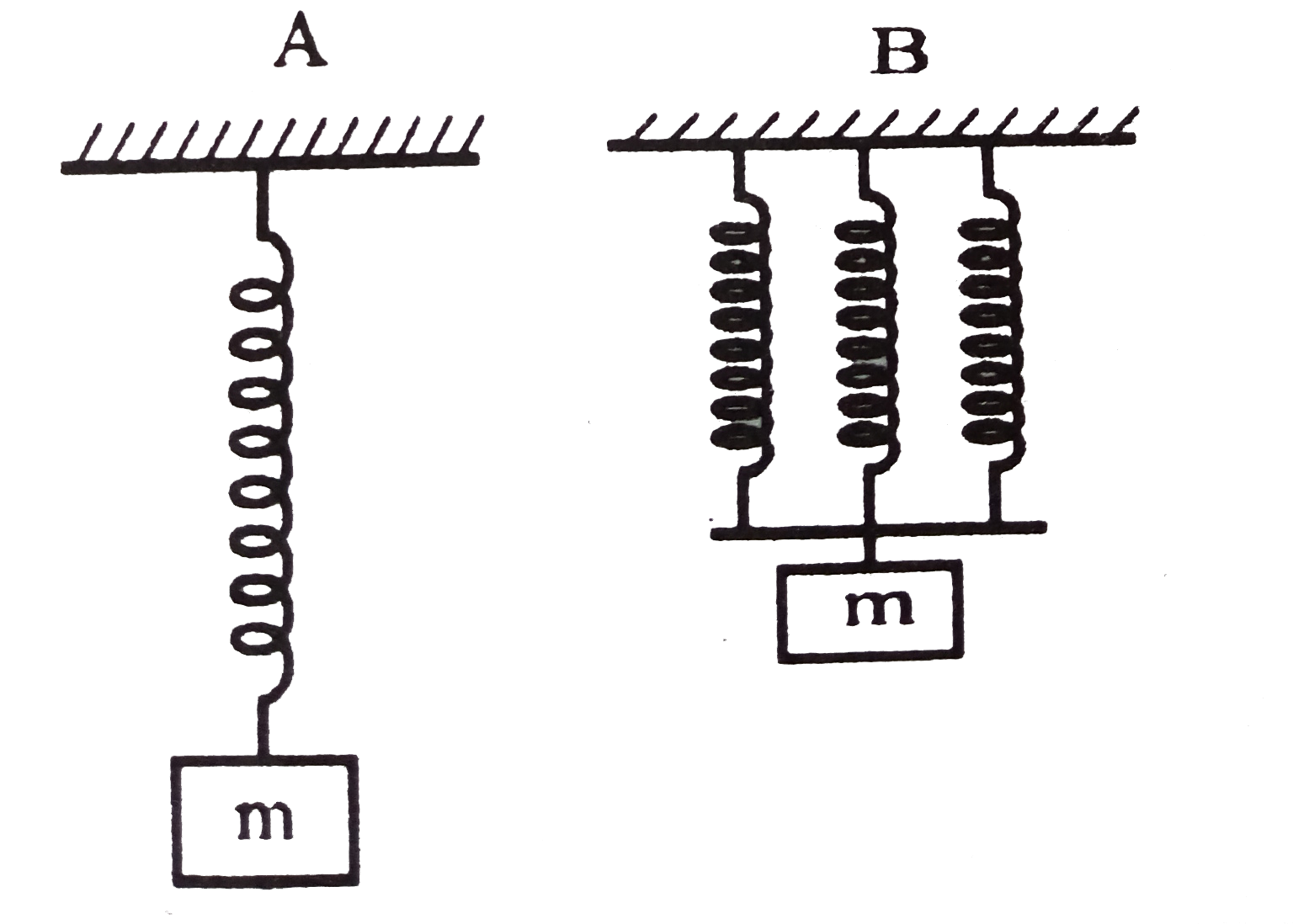Two springs A and B are identical to each other . The spring A is harder than the spring B . On which spring more work will be done if they are stretched by same force ?
To solve the problem, we need to analyze the work done on two springs A and B when they are stretched by the same force. Here’s a step-by-step breakdown of the solution:
Step 1: Understand the properties of the springs
- We know that both springs A and B are identical in size and shape. However, spring A is harder than spring B, which means that spring A has a higher spring constant (kA) compared to spring B (kB).
Step 2: Write the relationship between force, spring constant, and displacement
- The relationship between the force (F), spring constant (k), and displacement (x) for a spring is given by Hooke's Law:
F=k⋅x
- For spring A, we can write:
F=kA⋅xA
- For spring B, we can write:
F=kB⋅xB
Step 3: Set the equations equal to each other
- Since the same force is applied to both springs, we can equate the two equations:
kA⋅xA=kB⋅xB
Step 4: Analyze the relationship between displacements
- Since kA>kB, for the equation kA⋅xA=kB⋅xB to hold true, xA must be less than xB. This means:
xA<xB
Step 5: Calculate the work done on each spring
- The work done (W) on a spring when it is stretched is given by the formula:
W=12F⋅x
- For spring A:
WA=12F⋅xA
- For spring B:
WB=12F⋅xB
Step 6: Compare the work done on both springs
- Since xB>xA and the force (F) is the same for both springs, it follows that:
WB>WA
- Therefore, more work is done on spring B compared to spring A.
Conclusion:
- The work done on spring B is greater than the work done on spring A when both are stretched by the same force.
- We know that both springs A and B are identical in size and shape. However, spring A is harder than spring B, which means that spring A has a higher spring constant (kA) compared to spring B (kB).
- The relationship between the force (F), spring constant (k), and displacement (x) for a spring is given by Hooke's Law:
F=k⋅x
- For spring A, we can write:
F=kA⋅xA
- For spring B, we can write:
F=kB⋅xB
- Since the same force is applied to both springs, we can equate the two equations:
kA⋅xA=kB⋅xB
- Since kA>kB, for the equation kA⋅xA=kB⋅xB to hold true, xA must be less than xB. This means:
xA<xB
- The work done (W) on a spring when it is stretched is given by the formula:
W=12F⋅x
- For spring A:
WA=12F⋅xA
- For spring B:
WB=12F⋅xB
- Since xB>xA and the force (F) is the same for both springs, it follows that:
WB>WA
- Therefore, more work is done on spring B compared to spring A.
- The work done on spring B is greater than the work done on spring A when both are stretched by the same force.
Topper's Solved these Questions
Similar Questions
Two springs A and B are identical to each other . The spring A is harder than the spring B . On which spring more work will be done if they are streched by same force ?
View SolutionTwo springs A and B are identical to each other . The spring A is harder than the spring B . On which spring more work will be done if they are stretched by same force ?
View Solution
Knowledge Check
Two springs A and B are identical but A is harder than B (kA>kB). Let Wand Wg represent the work done when the springs are stretched through the same distance and W.AandW.B are the work done when these are stretched by equal forces, then which of the following is true?
AWA>WBandW.A=W.BBWA>WBandW.A<W.BCWA>WBandW.A>W.BDWA<WBandW.A<W.BThe springs in figure. A and B are identical but length in A is three times each of that in B.
(A) , (B)
, (B)  A√3B1/3C3D1/√3
A√3B1/3C3D1/√3Two springs A and B are identical except that A is stiffer than B i.e., kA>kB. If the two springs are stretched by the same force, then
Amore work is done on B i.e., WB>WABmore work is done on A i.e., WA>WBCwork done on A and B are equalDwork done depends upon the way in which they are stretched
Springs Aand B are identical except that A is stiffer than B. In which spring more work is done if(a) b othare stretched by same amount ? (b) both are stretched by the same force ?
View SolutionTwo springs A and B are identical except that A is harder than B(KA>KB) if these are stretched by the equal force. In which spring will more work be done?
View SolutionTwo springs have force constants K1 and K2 , where K1>K2. On which spring, more work is downe if
(i) they are stretched by the same force?
(ii) they are stretched by the same amount?
View SolutionSpring force and cutting OF springs
View SolutionTwo springs A and B are identical except that A is stiffer than B i.e., kA>kB. If the two springs are stretched by the same force, then
View Solution
